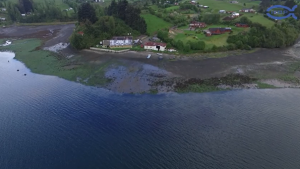IFOP installs wave measurement buoy within its environmental conditions of salmon farming monitoring program .
September 7th, 2021Among various efforts to understand the relationships between salmon aquaculture production and marine environment, within a sustainable development framework , in the coming years, concession groups (ACS) must implement an online monitoring and control system of relevant environmental parameters (temperature, salinity, oxygen, etc.) to monitor salmon farming neighborhoods in southern Chile. Within this framework, IFOP is responsible for receiving, storing and processing information collected by monitoring stations. With the aim of advancing of environmental processes knowledge and their interactions with salmon farming industry, this network will allow large-scale data (big data) analysis and will have a website for results dissemination , in addition to establish an early warning system.
There are currently about 1,400 concessioned salmon farming centers, distributed along 1,500 kilometers between Puerto Montt and Punta Arenas. Each of these farming centers is administratively located within one of the nearly 90 neighborhoods or ACS (groups of salmonid concessions), which are joint management areas in logistics, production and bio-health issues.
The monitoring network contemplates at least 1 buoy for each neighborhood installation and considers oceanographic and meteorological variables measurement , such as water and air temperature, salinity, pressure, currents, wind, fluorescence, turbidity, dissolved oxygen, pH and precipitation.
As a first stage in results in storage system and display implementation , IFOP acquired and installed a wave observation buoy, corresponding to the Spotter model of SOFAR an American brand (https://www.sofarocean.com/), in the Castro fjord, near IFOP facilities in Putemún. This instrument will be used to calibrate system reception and to carry out tests on data transmission and storage system. In the medium term, all the environmental information collected and processed will be displayed through the BOYAS web tool within the CHONOS website (http://chonos.ifop.cl/), a platform that brings together a series of explorers, analyzes and data visualization based on information from numerical models developed by IFOP for Chilean Patagonia.

